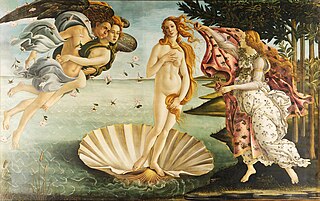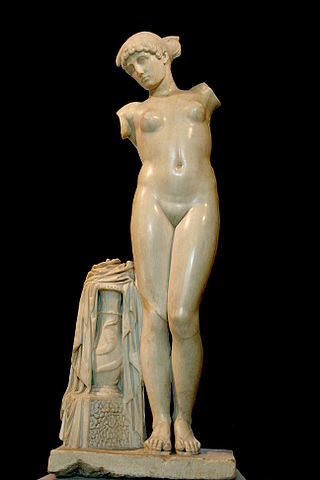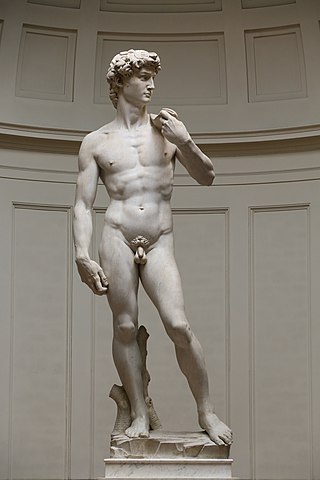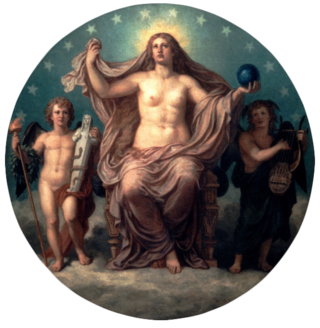
Aphrodite is an ancient Greek goddess associated with love, lust, beauty, pleasure, passion, procreation, and as her syncretized Roman goddess counterpart Venus, desire, sex, fertility, prosperity, and victory. Aphrodite's major symbols include seashells, myrtles, roses, doves, sparrows, and swans. The cult of Aphrodite was largely derived from that of the Phoenician goddess Astarte, a cognate of the East Semitic goddess Ishtar, whose cult was based on the Sumerian cult of Inanna. Aphrodite's main cult centers were Cythera, Cyprus, Corinth, and Athens. Her main festival was the Aphrodisia, which was celebrated annually in midsummer. In Laconia, Aphrodite was worshipped as a warrior goddess. She was also the patron goddess of prostitutes, an association which led early scholars to propose the concept of "sacred prostitution" in Greco-Roman culture, an idea which is now generally seen as erroneous.

Venus is a Roman goddess, whose functions encompass love, beauty, desire, sex, fertility, prosperity, and victory. In Roman mythology, she was the ancestor of the Roman people through her son, Aeneas, who survived the fall of Troy and fled to Italy. Julius Caesar claimed her as his ancestor. Venus was central to many religious festivals, and was revered in Roman religion under numerous cult titles.

In Greek mythology, the Charites, singular Charis, or Graces, were three or more goddesses of charm, beauty, nature, human creativity, goodwill, and fertility. Hesiod names three – Aglaea ("Shining"), Euphrosyne ("Joy"), and Thalia ("Blooming") – and names Aglaea as the youngest and the wife of Hephaestus. In Roman mythology they were known as the Gratiae, the "Graces". Some sources use the appellation "Charis" as the name of one of the Charites, and equate her with Aglaea, as she too is referred to as the wife of Hephaestus.

The Birth of Venus is a painting by the Italian artist Sandro Botticelli, probably executed in the mid 1480s. It depicts the goddess Venus arriving at the shore after her birth, when she had emerged from the sea fully-grown. The painting is in the Uffizi Gallery in Florence, Italy.

Apelles of Kos was a renowned painter of ancient Greece. Pliny the Elder, to whom much of modern scholars' knowledge of this artist is owed, rated him superior to preceding and subsequent artists. He dated Apelles to the 112th Olympiad, possibly because he had produced a portrait of Alexander the Great.

The Venus of Willendorf is an 11.1-centimetre-tall (4.4 in) Venus figurine estimated to have been made around 29,500 years ago. It was recovered on August 7, 1908 from an archaeological dig conducted by Josef Szombathy, Hugo Obermaier, and Josef Bayer at a Paleolithic site near Willendorf, a village in Lower Austria. The figurine was found by a workman named either Johann Veran or Josef Veram and is carved from an oolitic limestone that is not local to the area, and tinted with red ochre. It is in the Natural History Museum in Vienna, Austria as of 2003.

A Venus figurine is any Upper Palaeolithic statue portraying a woman, usually carved in the round. Most have been unearthed in Europe, but others have been found as far away as Siberia and distributed across much of Eurasia.

Venus Anadyomene is one of the iconic representations of the goddess Venus (Aphrodite), made famous in a much-admired painting by Apelles, now lost, but described in Pliny's Natural History, with the anecdote that the great Apelles employed Campaspe, a mistress of Alexander the Great, for his model. According to Athenaeus, the idea of Aphrodite rising from the sea was inspired by the courtesan Phryne, who, during the time of the festivals of the Eleusinia and Poseidonia, often swam nude in the sea. A scallop shell, often found in Venus Anadyomenes, is a symbol of the female vulva.

The Esquiline Venus, depicting the goddess Venus, is a smaller-than-life-size Roman nude marble sculpture of a female in sandals and a diadem headdress. It is widely viewed as a 1st-century AD Roman copy of a Greek original from the 1st century BC. It is also a possible depiction of the Ptolemaic ruler Cleopatra VII.

Venus Anadyomene is an oil painting by Titian, dating to around 1520. It depicts Venus rising from the sea and wringing her hair, with a shell visible at the bottom left, taken from a description of Venus by Greek poet Hesiod in which she was born fully-grown from a shell. The shell is smaller than usual in scenes of the birth of Venus, such as Botticelli's, and is just intended to identify the subject rather than be a boat-like vessel for Venus, as in Sandro Botticelli's The Birth of Venus and other depictions.

Doves, typically domestic pigeons white in plumage, are used in many settings as symbols of peace, freedom, or love. Doves appear in the symbolism of Judaism, Christianity, Islam and paganism, and of both military and pacifist groups.

The nude, as a form of visual art that focuses on the unclothed human figure, is an enduring tradition in Western art. It was a preoccupation of Ancient Greek art, and after a semi-dormant period in the Middle Ages returned to a central position with the Renaissance. Unclothed figures often also play a part in other types of art, such as history painting, including allegorical and religious art, portraiture, or the decorative arts. From prehistory to the earliest civilizations, nude female figures were generally understood to be symbols of fertility or well-being.

In classical mythology, Cupid is the god of desire, erotic love, attraction and affection. He is often portrayed as the son of the love goddess Venus and the god of war Mars. He is also known as Amor. His Greek counterpart is Eros. Although Eros is generally portrayed as a slender winged youth in Classical Greek art, during the Hellenistic period, he was increasingly portrayed as a chubby boy. During this time, his iconography acquired the bow and arrow that represent his source of power: a person, or even a deity, who is shot by Cupid's arrow is filled with uncontrollable desire. In myths, Cupid is a minor character who serves mostly to set the plot in motion. He is a main character only in the tale of Cupid and Psyche, when wounded by his own weapons, he experiences the ordeal of love. Although other extended stories are not told about him, his tradition is rich in poetic themes and visual scenarios, such as "Love conquers all" and the retaliatory punishment or torture of Cupid.

Aphrodite Urania was an epithet of the Greek goddess Aphrodite, signifying a "heavenly" or "spiritual" aspect descended from the sky-god Ouranos to distinguish her from the more earthly epithet of Aphrodite Pandemos, "Aphrodite for all the people". The two were used to differentiate the more "celestial" love of body and soul from purely physical lust. Plato represented her as a daughter of the Greek god Uranus, conceived and born without a mother. Hesiod described this aspect as being born from the severed genitals of Uranus and emerging from the sea foam.

The Calumny of Apelles is a panel painting in tempera by the Italian Renaissance painter Sandro Botticelli. Based on the description of a lost ancient painting by Apelles, the work was completed in about 1494–95, and is now in the Uffizi, Florence.

Primavera, is a large panel painting in tempera paint by the Italian Renaissance painter Sandro Botticelli made in the late 1470s or early 1480s. It has been described as "one of the most written about, and most controversial paintings in the world", and also "one of the most popular paintings in Western art".

Pregnancy in art covers any artistic work that portrays pregnancy. In art, as in life, it is often unclear whether an actual state of pregnancy is intended to be shown. A common visual indication is the gesture of the woman placing a protective open hand on her abdomen. Historically, married women were at some stage of pregnancy for much of their life until menopause, but the depiction of this in art is relatively uncommon, and generally restricted to some specific contexts. This probably persists even in contemporary culture; despite several recent artworks depicting heavily pregnant women, one writer was "astonished at the shortage of visual images ... of pregnant women in public visual culture". A research study conducted by Pierre Bourdieu in 1963 found that the great majority of 693 French subjects thought that a photo of a pregnant woman could not, by definition, be beautiful.

The Birth of Venus is a 1907 painting by the French artist Henri Gervex. It is now in the Petit Palais, in Paris. It depicts the Greek goddess Venus (Aphrodite) washed up to shore after her birth, when she had emerged from the sea fully-grown.

Artimpasa was a complex androgynous Scythian goddess of fertility who possessed power over sovereignty and the priestly force. Artimpasa was the Scythian variant of the Iranian goddess Arti/Aṣ̌i.





















